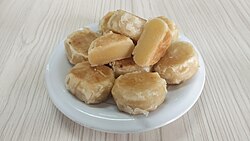Bakpia
 | |
| Alternative names | Hopia, Pia |
|---|---|
| Type | Pastry,sweet roll,kue |
| Course | Snack,dessert |
| Place of origin | IndonesiaandPhilippines |
| Region or state | Southeast Asia |
| Variations | Bakpia pathok |
Bakpia(Javanese:ꦧꦏ꧀ꦥꦶꦪ,romanized:bakpia;Chinese:Nhục bính;Pe̍h-ōe-jī:bah-piáⁿ;lit.'meat pastry'- the name it is known by inIndonesia) orHopia(Tagalog:[ˈhop.jɐʔ];Chinese:Hảo bính;Pe̍h-ōe-jī:hó-piáⁿ;lit.'good pastry' - the name it is known by in thePhilippines) is a popularIndonesianandPhilippinebean-filledmoon cake-like pastry originally introduced byFujianeseimmigrants in the urban centers of both nations around the past centuries. It is a widely available inexpensive treat and a favoured gift for families, friends and relatives.
In Indonesia, it is also widely known asbakpia pathok,named after a suburb ofYogyakartawhich specialises in the pastry.[1]Thesesweet rollsare similar to bigger Indonesianpia,the only difference being the size.
Types of dough
[edit]
Flaky type
[edit]The flaky type ofbakpiausesChinese puff pastry.Clear examples of this can be seen in China (especiallyMacau),Taiwanand countries with established Chinesediasporacommunities such asTrinidad and TobagoandGuyanamaking this type the authentic Chinesehopia.In addition, there is more skill involved in making this type ofhopiacrust.
Cake-dough type
[edit]Filipinohopiautilizes the cake-dough type in addition to the flaky type.
Fillings
[edit]Below are the four traditional and most popularbakpiaorhopiafillings, though recently other fillings have been created such ascappuccino,cheese,chocolate,custard,durian,mango,pineapple,screwpine (pandan),and umbi talas (taro).[2][3][4]
Mung bean
[edit]
The most popular flakybakpiain Indonesia andhopiain the Philippines is filled withmung bean,which is called inIndonesian:bakpia kacang hijauand inFilipino/Tagalog:Hopia mongo / Hopiang munggo,[5]sometimes referred to inTagalog:Hopiang matamis,lit. 'Sweet hopia'.As its name implies, it is filled with sweet split mung bean paste.
Pork
[edit]Pork hopia (Tagalog:Hopiang baboy / Hopia baboy)is filled with a savoury bread-crumb paste studded with candiedwintermelon,flavoured withscallionand enriched with candiedporkback fat, hence its name. This type ofhopiais also sometimes referred to ashopiang maalat(Tagalog for "saltyhopia").
Purple yam
[edit]
Ube hopia(Tagalog:Hopia ube / Hopiang ube) is a variant of hopia from thePhilippineswhich usepurple yam(Tagalog:ube;Cebuano:ubi). The filling is reminiscent ofhalayáng ube(ube jam), a traditional Filipino dessert eaten duringChristmas season.Like other ube-based dishes, it has a unique, vividvioletcolour and sweet taste.
Ube hopiawas first introduced in the 1980s by Gerry Chua ofEng Bee Tin,aChinese Filipinodelichain in theBinondodistrict ofManilanoted for theirfusionof Chinese and Filipino culinary traditions.[6][7][8]
Azuki bean
[edit]A variant from the Philippines that uses redazuki beanpaste is called inTagalog:Hopia hapón / Hopiang hapón,lit. 'Japanese hopia'. It differs from otherhopiain that it is made from cake dough. It is small and round and is similar in filling, crust texture, and style to theJapanesekurimanjū,hence its name. These are also often formed into cubes and cooked on a griddle one side at a time instead of being baked in an oven.[9]
See also
[edit]References
[edit]- ^A Budi Kurniawan, Erwin E Prasetya (January 3, 2014)."Bakpia, Buah Tangan Toleransi dan Akulturasi".Kompas.com(in Indonesian).Archivedfrom the original on January 12, 2015.RetrievedJanuary 13,2015.
- ^"Bakpia Pathuk Kini Memiliki Varian Rasa".May 3, 2016.
- ^"Dayat Story Blogs".Archivedfrom the original on August 18, 2012.RetrievedJuly 15,2012.Dayat Story Blogs (Indonesian)
- ^"New Innovation: HOPIA CUSTARD CLASSIC and UBE".YouTube.June 9, 2012.Archivedfrom the original on February 14, 2015.RetrievedFebruary 12,2015.
- ^http://www.bakpiajogkem.comArchivedNovember 4, 2014, at theWayback MachineBakpia Jogja Kembali
- ^"Eng Bee Tin".engbeetin.com.Archived fromthe originalon February 12, 2015.RetrievedFebruary 12,2015.
- ^"Chinese rice cake popular in Philippines".China Central Television. October 2, 2013. Archived fromthe originalon February 8, 2017.RetrievedFebruary 7,2017.
- ^Dolly Dy-Zulueta (January 7, 2013)."More Than Just Hopia and Tikoy".Flavors of Life.Archivedfrom the original on February 8, 2017.RetrievedFebruary 7,2017.
- ^"Homemade Hopiang Hapon Recipe".Mama's Guide Recipes.RetrievedAugust 25,2022.


